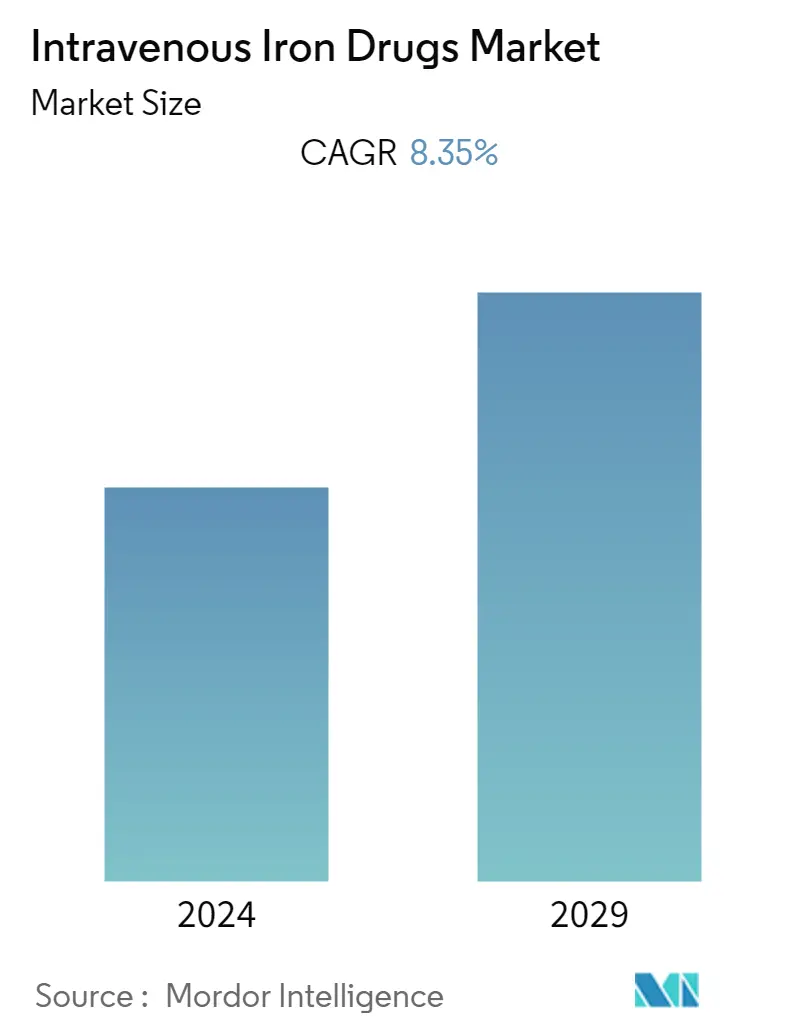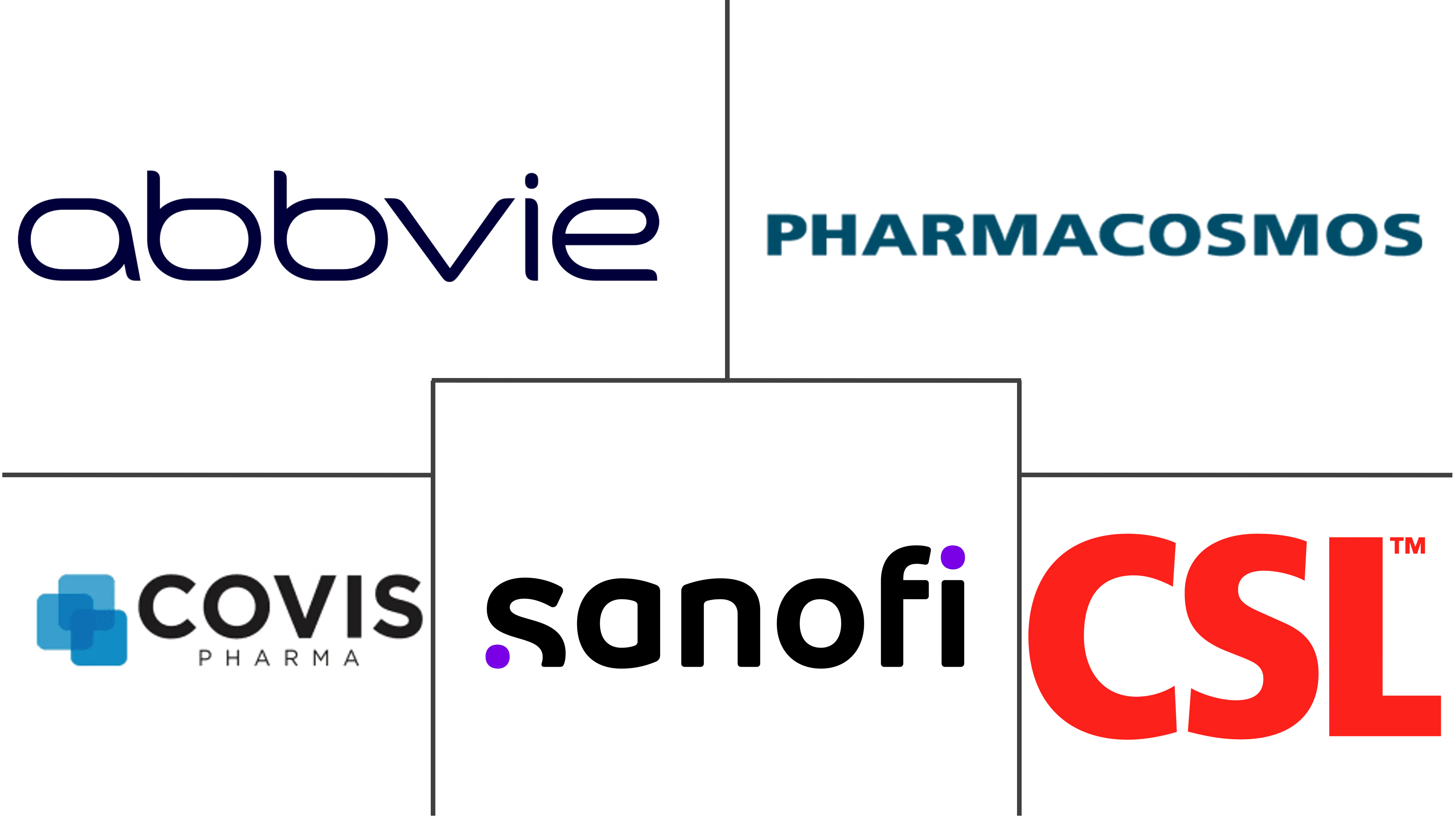Market Size of Intravenous Iron Drugs Industry

| Study Period | 2019 - 2029 |
| Base Year For Estimation | 2023 |
| CAGR | 8.35 % |
| Fastest Growing Market | Asia-Pacific |
| Largest Market | North America |
| Market Concentration | Medium |
Major Players
*Disclaimer: Major Players sorted in no particular order |
Need a report that reflects how COVID-19 has impacted this market and its growth?
Intravenous Iron Drugs Market Analysis
The intravenous iron drugs market is expected to grow at a significant CAGR of 8.35% during the forecast period.
During the pandemic, there is a slight decline in the intravenous iron drugs market due to the disruption of the supply chain and manufacturing process. But the market recovered soon and has grown subsequently, as there was a high demand for intravenous iron drugs, due to the increased risk of chronic kidney failure (CKD)-related anemia in COVID-19 patients. Furthermore, as per the article published by PubMed in August 2021, an older patient with numerous concomitant conditions who was hospitalized for COVID-19 was treated for iron deficient anemia with ferric carboxymaltose (Ferinjectâ, Vifor International). The medication caused the hemoglobin (Hb) to return to normal, the iron reserves to quickly restock, and the transferrin saturation to simultaneously improve. In cases of severe patients with diffuse coagulopathy, like the one in the present case, ferric carboxymaltose can be thought of as a viable option to treat anemia while a patient is being treated in a hospital for COVID-19 and avoid transfusion regimens. Hence as per the facts mentioned above, COVID-19 had a significant impact on the intravenous iron drugs market. However, as the pandemic has subsided, the studied the market is expected to have a stable growth during the forecast period of the study.
Certain factors driving the market growth include the increasing prevalence of target diseases such as chronic kidney disease-related anemia, irritable bowel syndrome, cancer-related anemia, disadvantages of oral iron drugs, and an increasingly aging population. For instance, as per the article published by PubMed in July 2022, a study was conducted which showed that IV iron for the treatment of cancer-induced anemia (CIA) reduces the need for red blood cells (RBC) transfusions and is not associated with adverse events. IV iron for the treatment of cancer-induced anemia should be considered in clinical practice.
Furthermore, government initiatives, research, and development in the field of IV iron drugs and the presence of competitors boost the market growth. For instance, in February 2021, The National Medical Products Administration (NMPA) in China approved Monofer (Ferric Derisomaltose) injection 100 mg/mL developed by Pharmacosmos. Monofer is an intravenous iron that is used in adult patients who have an intolerance to oral iron or unsatisfactory response to oral iron, or when there is a clinical need to administer iron quickly.
Apart from this, iron deficiency anemia is another common consequence of inflammatory bowel disease (IBD). For instance, according to an article published by PubMed Central in November 2022, iron deficiency (ID) and anemia in patients with inflammatory bowel disease (IBD) is often associated with a reduced quality of life. The article also stated that a study was conducted among a few IBD patients in the Netherlands, and it was found that the overall prevalence of anemia, iron deficiency and iron deficiency anemia was 18.0%, 43.4%, and 12.2%, respectively. Intravenous iron drugs are preferred for the treatment of IBD associated with iron deficiency anemia. Oral iron supplementation is the most frequent iron-deficient anemia treatment; however, it has been linked to gastro intestinal (GI) side effects such as constipation and bloating. Due to the lack of exposure to the intestinal lumen, intravenous iron drugs do not elicit gastro intestinal adverse effects. Therefore, chronic diseases such as CKD and IBD have resulted in persistent and prolonged anemia, fueling the growth of the intravenous iron drugs market.
Hence, due to the factors mentioned above such as the government initiatives, research, and development in the field of IV iron drugs, and increasing effectivity of IV iron drugs in cancer related anemia and irritable bowel disease, the studied market is anticipated to grow over the forecast period. However, adverse reactions associated with intravenous iron drugs restrain the market growth.
